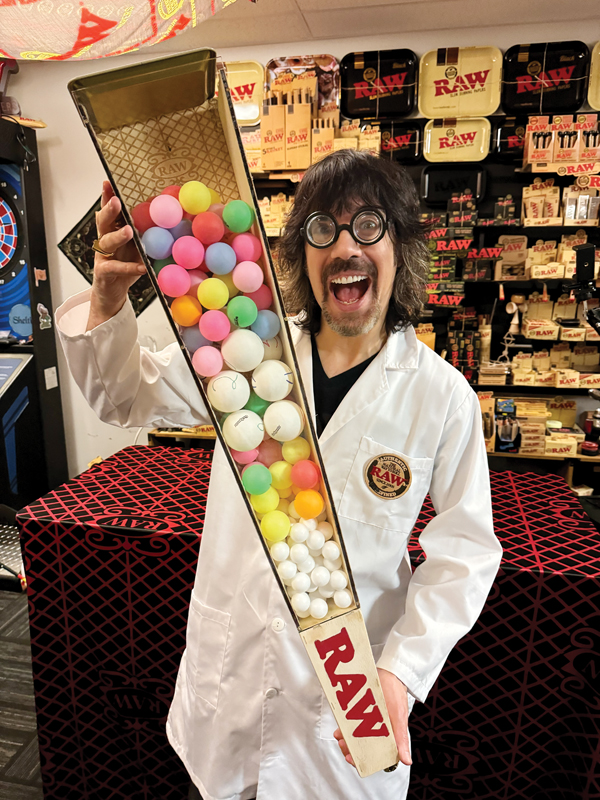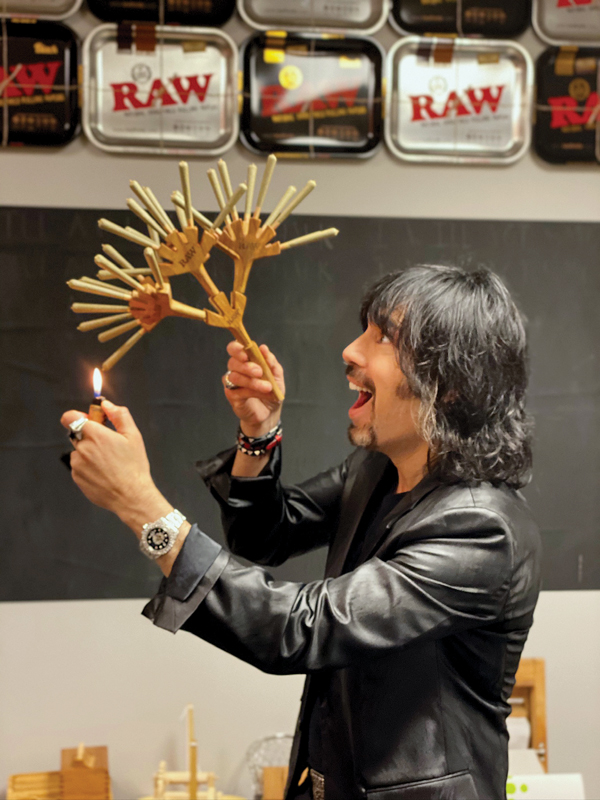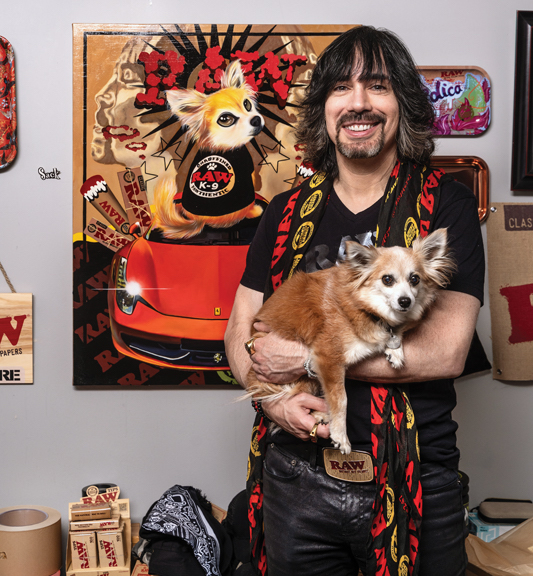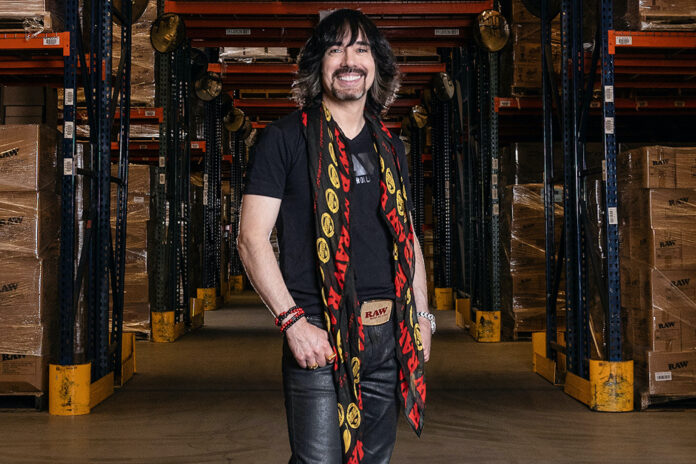Of all the challenges companies face in the competitive United States market, building brand allegiance is one of the most daunting. Consumers, both new-to-the-plant and experienced, can be a fickle crowd. As a result, very few brands have a dedicated following. Tight marketing budgets and limited advertising opportunities make building a following even more challenging. But for brands that have cracked the code and carved out a loyal customer base, life is good.
RAW rolling papers is one such brand.
By the time Josh Kesselman launched the brand in 2005, he had been buying and selling rolling papers from around the world for many years. He also had researched the materials and manufacturing processes European companies have employed for centuries. Kesselman had a vision for what he wanted to create: a vessel for smoking cannabis that wouldn’t interfere with the unique, delicate flavors and aromas the plant produces. In addition, he wanted the product to be made from unbleached plant material and free of chemicals, additives, and dyes. And, in a market where all the papers were white, he wanted his papers to be brown.
Kesselman realized his vision for a “better” rolling paper might mean producing a niche product that would appeal only to connoisseurs, but he had faith the old guard and purists would appreciate his work and word would spread: Build it, and they will smoke.
“We got [the papers] into the smoke circles every chance we got and were giving out free packs to people you could tell were real stoners,” he said. “Once the product made it into the sesh circles, people started saying ’Hey, what is this? It tastes different. It hits different. It doesn’t have that chalky residue. What is this?’ There was something about RAW that was different from everything else that was out. It didn’t have certain chemicals that many rolling papers had, and it wasn’t bleached.”
As word spread about the quirky new brown papers, high-profile rappers including Wiz Khalifa and Curren$y began calling out the brand in their work.
“I was in my car one day, and I got a call from Warner Music that Wiz had done a song about RAW papers,” Kesselman said. “I hadn’t paid Wiz anything. I was sending him papers because his people told me he loved my papers. But I was like, what? Sure enough, they played me the song over my phone. And it wasn’t done for money.
“We did a collab[oration] with him afterwards, but that was more of a thank you rather than ‘hey, I’m going to pay you to do something.’”
Kesselman embarked upon his entrepreneurial journey in the early 1990s when he opened a modest smoke shop in Gainesville, Florida. He would order almost anything customers requested and learned about new products from the members of the community who used them. At the time, he was trading rolling papers with collectors in Europe and buying whatever “exotic” papers he could, then reselling them to curious customers who dropped into his store. The experience gave him a taste for running a business … until the store was forced to close after an employee sold a bong to the daughter of a high-ranking U.S. Customs Service official.
Undeterred, Kesselman followed the prevailing winds and moved to Arizona, which he called “the paraphernalia capital of America” at the time. Shortly thereafter, an encounter with a Spanish businessman at a trade conference proved one of the most significant moments in his entrepreneurial career. The chance meeting led to the creation of Kesselman’s first successful rolling paper brands: Elements and Juicy Jay’s. His experiences founding and growing those brands led to the establishment of RAW.
As anyone who has encountered Kesselman can attest, his enthusiasm for his brands and products is part and parcel of his personality. He especially enjoys dreaming up new products that are meant to be both functional and whimsical and harken back to the wacky paraphernalia he and his friends toyed with in the 1980s. He also takes joy in creating humorous, over-the-top videos for the company’s social media channels. With 3.6 million followers on Instagram, @rawlife247 has one of the largest followings of any company in the industry, and Kesselman is only too happy to keep feeding the masses new content.
On the cusp of RAW’s twentieth anniversary in 2025, Kesselman seems as enthusiastic as ever about his company and as eager to connect the past to the present for consumers who like to roll their own.

What was your first business deal in the rolling-papers realm?
I was looking for papers and connected at a trade show with an older Spanish man, and I was very young at that point. He said, “Josh, why do you even care about rolling papers?” He was sitting there staring at me because he thought he was going to meet a businessman, but I had long hair and my biker shit on, and he was like, “Who is this kid?”
I could tell I was losing him, so I told him the story about my dad’s magic trick with rolling papers: lighting a paper and tossing it up in the air to make it disappear. The brand my dad used was Marfíl Arroz, which no longer existed.
As soon as I said the brand’s name, [the Spanish gentleman’s] face lit up. He told me his father and grandfather produced that brand. I decided we had to bring it back, and right then was when I had the idea to start making my own rolling papers. I named the first brand Elements after the elements used to make the rice-style paper. We couldn’t call it Marfíl Arroz, because when mega-tobacco bankrupted the old factory with litigation, they took away the trademarks. Nobody could use any of the names. So, Elements is really just an homage to the past, and it did very well. That was in the late ’90s, and I was thrilled.
Did you run into any challenges getting unconventional rolling papers off the ground?
I remember going to the mills to try to get someone to make this base sheet that no one had ever seen before. I tried talking to the paper manufacturers about what I was looking for—which was this translucent brown, organic-inspired paper that I could only envision in my head—and no one would do it. They’d never done this kind of thing. All I got was “no, no, no, no.”
I was very upset about this, but then I realized I was asking the question the wrong way. So, I went back to one small mill and said to them, “Hey, if I ordered 100,000 tons of this, you would make it, right?” They said, “Yes, of course.”
And voilà! The first booklets of RAW were born. We did some test booklets throughout the 2000s, but the first real launch—when we finally got in a real shipment—was in 2005. So, we’re about to hit our twenty-year anniversary.
Your Instagram videos are reminiscent of the Crazy Eddie commercials in the 1980s. Was that part of your inspiration?
My inspiration was Mr. Rogers. Even to this day, if a Mr. Rogers video shows up on social media, I just watch it and listen to him talk. It brings me back into that complete place of stillness [I experienced when I watched him as a kid]. It’s like a kind of meditation.
Crazy Eddie is definitely an influence in my life, too. I have that energy in me, and I’ll tell you why. I grew up with a stutter, and when my grandma took me to a speech therapist, the person was trying to make me feel better and told me, “It’s not that you’re stuttering; it’s that your brain is moving faster than your mouth can work.” I walked out of there and thought about that and realized I just need to talk faster.
Humor obviously is a big part of your social media presence, but what inspires you to make videos promoting your brand? What is your creative process?
I picture Timmy every time I make a video. Timmy is this character I made up in my head, and he lives in a very low-cost place, like some smallish town in Iowa. He works in fast food. He’s really not happy with his life, but he loves getting stoned on weekends with his friends. Obviously, I was Timmy. You get that, right? And so when I’m doing my videos, I’m basically saying, “Timmy, check this out. Here’s a cool thing. Take out this ring and there is a holder in it for your joint, bro.” The videos are really all directed at Timmy, my former self who loved all that stoner stuff.

Where did the RAW umbrella idea come from?
I was out getting stoned in the rain, and I just made a holder on the umbrella. And we realized closing the umbrella would crush it, so I had to build a holder into the handle. We’re just like, “Oh, this [product] would be so perfect. There’s no one else on planet Earth who’s gonna make a stoner umbrella besides me. So I gotta do this, and I gotta make it right.” And since I lived in Arizona, I had to make it for sun and rain. I had to make it something that people were not embarrassed to use. So I made it this metallic gold, because metallics generally reflect solar light, which is something I’ve learned by studying [ultraviolet radiation]. Then I thought, “I’ll put the RAW logo on it so people won’t be embarrassed. It’s gonna be cool. I’m gonna make sun umbrellas cool. This is gonna be awesome.”
And thus, three years later, the RAW sun umbrella was born. Before I launched it, I didn’t understand people drop umbrellas. The little mouthpiece can break if people drop it the wrong way. So then I had to make a version two with a rubber mouthpiece to make sure it doesn’t break and send [one of the new models] to everyone who got a first version.
What qualities make one rolling paper “better” than another?
There’s different ways to make rolling paper, but my preferred way is to make it as minimalist as humanly possible. You adjust the burn based on something called a CORESTA [Cooperation Centre for Scientific Research Relative to Tobacco] unit. CORESTA measures the amount of air you allow to pass through the paper to feed the ember so it doesn’t go out. If you let in too much air, then you’re diluting the hits, and you end up with the “light cigarette” effect where you’re pulling on the joint, the ember lights up, but you’re not getting that much smoke. Instead, you’re getting a lot of air, and that ember can continue to burn for a long time afterward because of all that oxygen.
Big Cannabis would probably love that, because you’re going to waste a whole bunch of weed. But a real rolling paper craftsman is going to hate that, because you’re trying to keep the ember alive long enough to serve for the next puff and for it to go out in a reasonable amount of time. [Manufacturers are] constantly adjusting their CORESTA to try to achieve that effect, which is where art really comes into play. You can add chemicals, which some people do. We do not. In order to control the burn, we prefer do it this simple way of just air flow through the paper.
There are companies using wood, rice, hemp, flax, and other raw materials to manufacture rolling papers. What is the best material, in your opinion?
There is no single best material. It’s really like pairing wine with cheese: It depends on your weed and its moisture content, the actual strain, the way it burns, its oil content. All of this is going to pair differently with different papers. Also, the flavor is going to change. There’s the overall art.
The industry believes the overarching, overall best material, which is used for most cigarettes and most rolling papers, is different forms of soft wood. You have to pick which one actually has the flavor you’re looking for. Hemp is very popular, but hemp can have a little bit stronger, earthier flavor that only pairs with certain strains, whereas a wood-pulp-based paper is more universal in my experience.
What has surprised you the most about the way the U.S. cannabis industry has developed over the past ten or so years?
The thing that made me sad is “frankenweed.” It’s like someone said, “Here’s what I’m going to do: I’m so smart, I’m going to follow what mega-tobacco does.” So, they take the plant—it doesn’t matter if it’s tobacco or cannabis—they take all the actives out of it, and then they add them back in a controlled dose and mash it up into a pulp. It’s almost as if they’re making paper and spreading it out into sheets, spraying the actives or mixing the actives back in, and then cutting it up and shredding it so it looks like something. Maybe they add a green dye back into it, or brown dye, in order to make it look more like what they’re trying to mimic. And now we have this generic, homogenized cannabinoid product. That just pains me. This is a plant that was put here by nature itself. It grew here for millennia, and now some of us are taking it and just destroying it.
What advice do you give people who come to you with ideas about new paraphernalia products?
My advice to them is this: Is your product truly unique? Does it uplift people and make it easier for them to roll a joint or make it easier for them to grind or fill a joint? Is there a benefit to our culture and our community? If so, what’s the benefit? Show me. That’s the first thing I push them on. After that, is it easy to use? Are people going to figure this out, or is it one of these complex things? Because those break my heart. There’s no way my people are going to figure that out. There’s ten steps? No. It has to be easy. Remove yourself from it for a moment and think, how does this truly benefit our community? And if you can come up with a convincing argument, then I would love to hear it.
Whatever you do, if you are an also-ran, then don’t even talk to me.
What developments do you think we’ll see over the next five years?
If you want to see what’s going to happen in the U.S., look at Canada. You can expect what we’re seeing up there. There’s been a boom and then a bust. It will happen here too.
As soon as we get real federal legalization, there will be a boom and then a bust. There’s going to be even more money coming in and even more money lost. There’s going to be a bunch of scammers out there and—in the end, what happens when the pieces fall down and everything gets settled—consumption rates are going to remain flat to where they were before legalization. If anything, if we follow the alcohol model from the 1920s, consumption actually will go down after legalization.













